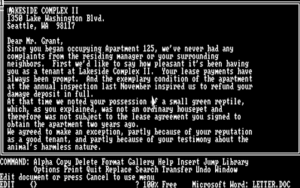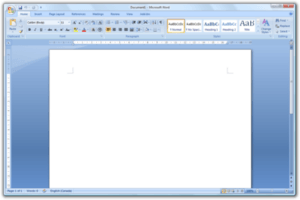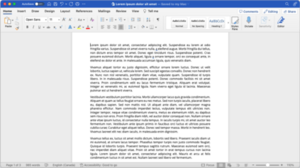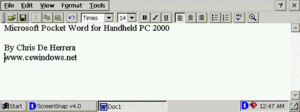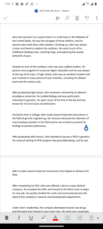Microsoft Word facts for kids
 |
|||||||||||||||
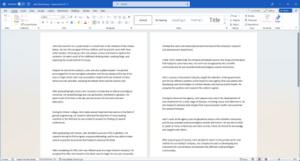
Microsoft Office 365 version of Microsoft Word, with the new redesign applied
|
|||||||||||||||
| Other names | Multi-Tool Word | ||||||||||||||
|---|---|---|---|---|---|---|---|---|---|---|---|---|---|---|---|
| Developer(s) | Microsoft | ||||||||||||||
| Initial release | October 25, 1983 | ||||||||||||||
| Stable release(s) | |||||||||||||||
|
Latest versions (365 and Office)
Latest versions (standalone app)
|
|||||||||||||||
| Written in | C++ (back-end), Objective-C (API/UI on Mac) | ||||||||||||||
| Operating system | Windows, macOS, Android, iOS (current versions) | ||||||||||||||
| Platform | IA-32, x86-64, Arm, Arm64 | ||||||||||||||
| Predecessor | Multi-Tool Word or WordPad | ||||||||||||||
| Type | Word processor | ||||||||||||||
| License | Trialware | ||||||||||||||
Microsoft Word is a popular computer program made by Microsoft. It helps you write and edit text documents. Think of it like a super-smart digital notebook where you can type stories, reports, or anything else.
It first came out on October 25, 1983, and was originally called Multi-Tool Word. Over the years, it has been made to work on many different types of computers and devices. This includes Windows computers, Macs, Android phones, and iOS devices like iPhones and iPads.
Since the 1990s, Microsoft Word has been the most used word processing software. You can get Word by itself or as part of a bigger collection of programs called Microsoft Office. This can be a one-time purchase or a subscription service called Microsoft 365.
Contents
The Story of Word
In 1981, Microsoft hired a smart developer named Charles Simonyi. He had worked on one of the first word processors that showed you what your document would look like as you typed. This is called WYSIWYG (What You See Is What You Get).
Simonyi started creating a new word processor, first called Multi-Tool Word. Soon, another talented engineer, Richard Brodie, joined him.
Microsoft announced Multi-Tool Word in 1983. Its name was quickly shortened to Microsoft Word. To help people try it out, free copies were given away with a magazine called PC World. This was a new way to share software back then!
Early versions of Word for MS-DOS were special because they were designed to be used with a mouse. Most other programs at the time used only the keyboard. Word also let you easily undo mistakes and see bold, italic, or underlined text on screen.
It wasn't instantly popular because it was different from other programs. But Microsoft kept making it better. In 1985, Word was made available for Mac computers. This version was very popular because it offered more features than other Mac word processors.
In 1989, the first version of Word for Microsoft Windows came out. When Windows 3.0 was released the next year, Word's sales really took off. It quickly became the top word processor for Windows computers.
In 1993, Microsoft released Word 6.0. This version tried to make the program look and feel the same across different computer types. It also added cool new features like AutoCorrect, which fixes common typing errors, and AutoFormat, which can quickly change how a document looks.
How Word Saves Your Work
Word uses special ways to save your documents so you can open them later.
File Types and Names
Microsoft Word documents usually end with either `.doc` or `.docx`. These are like special labels that tell your computer it's a Word file.
The `.doc` extension was used for many older versions of Word. It actually covered several different ways Word saved files over the years.
The newer `.docx` extension is used by default since Word 2007. This format is based on an international standard called Office Open XML. It helps make sure your documents can be opened and shared easily.
Older File Formats
From the late 1990s to the early 2000s, the `.doc` format was very common. These older files were complex because Word had many features. They were designed to work fast.
Even today, Word 2007 and newer versions can still open and save `.doc` files. However, `.docx` is the main way it saves files now.
Newer XML Format
Word 2003 introduced a new way to save files using XML. This was called WordProcessingML or WordML. It was a simpler, text-based way to store documents.
These XML formats were later replaced by the Office Open XML standard in Word 2007.
Opening Files from Different Versions
Sometimes, if you open a Word document made in a newer version with an older version of Word, it might not look exactly right. This is because newer versions have more features. If an older version doesn't understand a new feature, it might not show it correctly.
To help with this, Word can also save files in a format called Rich Text Format (RTF). This format helps keep most of the formatting and all the text when you share documents between different programs.
Other File Types Word Can Use
Word can also work with other file types using special add-ons. For example, it can open and save documents in the OpenDocument format (ODF). This is another international standard for office documents.
Since Office 2007 Service Pack 2, Word can read and save ODF files directly. Word 2007 and later versions can also save documents as PDF and XPS files. These are great for sharing documents that you don't want others to change.
Cool Features of Word
Word has many tools to help you create amazing documents.
- Spell Checker and Thesaurus: It can check your spelling and grammar. It also has a thesaurus to help you find different words.
- Tables: You can easily create tables to organize information.
- Calculations: Some versions can even do simple math and help you format math equations.
Here are some other neat features:
Templates
Word comes with many ready-made designs called templates. These templates help you quickly start a document with a specific look, like a resume or a flyer.
You can also create your own templates. This lets you set up your favorite fonts, margins, and styles. For example, the `Normal.dotm` template is the basic one for all new documents. You can change it to set your own default settings.
Pictures and Graphics
Word lets you put pictures into your documents. It supports common picture types like JPG and GIF. Since 2017, it also supports SVG images, which are great because they look clear at any size.
WordArt
WordArt is a fun feature that lets you make text look artistic. You can add shadows, reflections, or even make text look 3D. It's perfect for titles or special headings. You can still spell-check text that uses WordArt effects.
Macros
A macro is like a mini-program that automates tasks in Word. If you do the same steps over and over, you can record a macro to do it for you with one click. This can save a lot of time!
Older versions of Word used a language called WordBasic for macros. Since Word 97, it uses Visual Basic for Applications.
However, macros can sometimes be used to spread viruses. Because people often share Word files, this was a problem in the past. Microsoft has improved security settings to make macro viruses much less common now. By default, Word's security is set to HIGH, which helps protect you.
Hidden Text
Word lets you mark some text as "hidden." This text is stored in the document but doesn't show up on the screen. It can be useful for notes or extra information that you don't want everyone to see.
Password Protection
You can protect your Word documents with passwords. There are a few types:
- Password to open: This is the strongest protection. Without the password, no one can open the document.
- Password to modify: This lets people open the document but stops them from making changes without the password.
- Password restricting formatting and editing: This allows shared use but limits what changes can be made.
Over the years, Microsoft has made password protection much stronger. Modern versions of Word use advanced encryption, making it very hard for unauthorized people to access your files.
Word on Different Computers and Devices
Word for Windows
Word for Windows is the most common version. It's known for its many features and is widely used for creating documents. Because so many people use it, Word files are often shared via email.
Word 2007 introduced a big change: the Ribbon interface. This new design organizes tools into tabs, making it easier to find what you need. This Ribbon design was later added to other Microsoft Office programs.
Word 2010 allowed you to customize the Ribbon and added a "Backstage view" for managing files. It also made it easier to add screenshots and connect with online services like OneDrive.
Newer versions like Word 2019 and Word 2021 added features like dictation (speaking to type), co-authoring (working on a document with others at the same time), and a dark mode for easier viewing. Word 2024 also improved collaboration features.
Word for Mac
Microsoft released Word for Mac in 1985, just a year after the first Mac computer came out. This early Mac version was very advanced for its time, showing what the document would look like on screen.
Word 5.1 for Mac, released in 1992, was very popular. Many users still remember it as one of the best versions for Mac.
In 1997, Microsoft created a special team just for Mac software. They released Word 98 for Mac, which had many features from the Windows version.
Word X (2001) was the first version made specifically for Mac OS X. Word 2008 introduced a Ribbon-like feature called the Elements Gallery. Word 2011 brought the Ribbon interface even closer to the Windows version.
Recent Mac versions, like Word 2021 and Word 2024, also include real-time co-authoring, dark mode, and other modern features.
Word on Mobile Devices
The first versions of Word for mobile devices came out in 1996 for Windows CE devices. These were simpler versions for small handheld computers.
Today, Word Mobile is available for phones and tablets. It lets you do basic things like bold text, change font size, and add comments. While it's great for quick edits, it doesn't have all the advanced features of the desktop version.
Word for iOS (iPhones and iPads) was released in 2014, and for Android in 2015.
Word for the Web
Word for the web is a free, simpler version of Microsoft Word that you can use in your web browser. It's part of Office on the web, which also includes web versions of Excel and PowerPoint.
While it's very handy for quick edits and viewing documents online, it doesn't have all the features of the full desktop Word program. For example, some advanced design tools or mail merge options are only in the desktop app.
Word Release History
Here's a look at when different versions of Word came out for various computers.
| Year released | Name | Version | Comments |
|---|---|---|---|
| 1989 | Word for Windows 1.0 | 1.0 | Code-named Opus |
| 1990 | Word for Windows 1.1 | 1.1 | For Windows 3.0. Code-named Bill the Cat |
| 1990 | Word for Windows 1.1a | 1.1a | In 2014, Microsoft made the source code for this version available to the public. |
| 1991 | Word for Windows 2.0 | 2.0 | Included in Office 3.0. |
| 1993 | Word for Windows 6.0 | 6.0 | Version numbers 3, 4, and 5 were skipped to match other versions. Included in Office 4.0, 4.2, and 4.3. |
| 1995 | Word for Windows 95 | 7.0 | Included in Office 95 |
| 1997 | Word 97 | 8.0 | Included in Office 97 |
| 1998 | Word 98 | 8.5 | Included in Office 97 |
| 1999 | Word 2000 | 9.0 | Included in Office 2000 |
| 2001 | Word 2002 | 10.0 | Included in Office XP |
| 2003 | Office Word 2003 | 11.0 | Included in Office 2003 |
| 2006 | Office Word 2007 | 12.0 | Included in Office 2007; released to businesses in November 2006, to consumers in January 2007. |
| 2010 | Word 2010 | 14.0 | Included in Office 2010; version 13.0 was skipped. |
| 2013 | Word 2013 | 15.0 | Included in Office 2013 |
| 2016 | Word 2016 | 16.0 | Included in Office 2016 |
| 2019 | Word 2019 | 17.0 | Included in Microsoft Office 2019 |
| 2021 | Word 2021 | 17.0 | Included in Microsoft Office 2021 |
| 2024 | Word 2024 | 17.0 | Included in Microsoft Office 2024 |
| Year released | Name | Version | Comments |
|---|---|---|---|
| 1985 | Word 1 | 1.0 | |
| 1987 | Word 3 | 3.0 | |
| 1989 | Word 4 | 4.0 | Part of Office 1.0 and 1.5 |
| 1991 | Word 5 | 5.0 | Part of Office 3.0. |
| 1992 | Word 5.1 | 5.1 | Part of Office 3.0. Last version for older Mac computers. |
| 1993 | Word 6 | 6.0 | Part of Office 4.2. Shared code with Word for Windows 6. |
| 1998 | Word 98 | 8.5 | Part of Office 98 Macintosh Edition. |
| 2000 | Word 2001 | 9.0 | Part of Microsoft Office 2001. Last version compatible with older Mac OS. |
| 2001 | Word v. X | 10.0 | Part of Office v. X. First version for Mac OS X only. |
| 2004 | Word 2004 | 11.0 | Part of Office 2004 |
| 2008 | Word 2008 | 12.0 | Part of Office 2008. First version for Intel-based Macs. |
| 2010 | Word 2011 | 14.0 | Part of Office 2011; version 13.0 was skipped. |
| 2015 | Word 2016 | 16.0 | Part of Office 2016; version 15.0 was skipped. |
| 2019 | Word 2019 | 17.0 | Included in Microsoft Office 2019 |
| 2021 | Word 2021 | 17.0 | Included in Microsoft Office 2021 |
| 2024 | Word 2024 | 17.0 | Included in Microsoft Office 2024 |
| Year released | Name | Version | Comments |
|---|---|---|---|
| 1983 | Word 1 | 1.0 | Initial version of Word |
| 1985 | Word 2 | 2.0 | |
| 1986 | Word 3 | 3.0 | Copy protection was removed. |
| 1987 | Word 4 | 4.0 | |
| 1989 | Word 5 | 5.0 | |
| 1991 | Word 5.1 | 5.1 | |
| 1991 | Word 5.5 | 5.5 | First DOS version with a Windows-like look. |
| 1993 | Word 6 | 6.0 | Last DOS version. |
| Platform | Year released | Name | Comments |
|---|---|---|---|
| Atari ST | 1988 | Microsoft Write | Based on Microsoft Word 1.05 for Mac OS. |
| OS/2 | 1989 | Microsoft Word 5.0 | Could run on both MS-DOS or OS/2. |
| OS/2 | 1991 | Microsoft Word 5.5 | Could run on both MS-DOS or OS/2. |
| OS/2 | 1990 | Microsoft Word for OS/2 Presentation Manager version 1.1 | |
| OS/2 | 1991 | Microsoft Word for OS/2 Presentation Manager version 1.2 | |
| SCO Unix | 1990 | Microsoft Word for Unix version 5.0 | |
| SCO Unix | 1991 | Microsoft Word for Unix version 5.1 |
See also
 In Spanish: Microsoft Word para niños
In Spanish: Microsoft Word para niños


